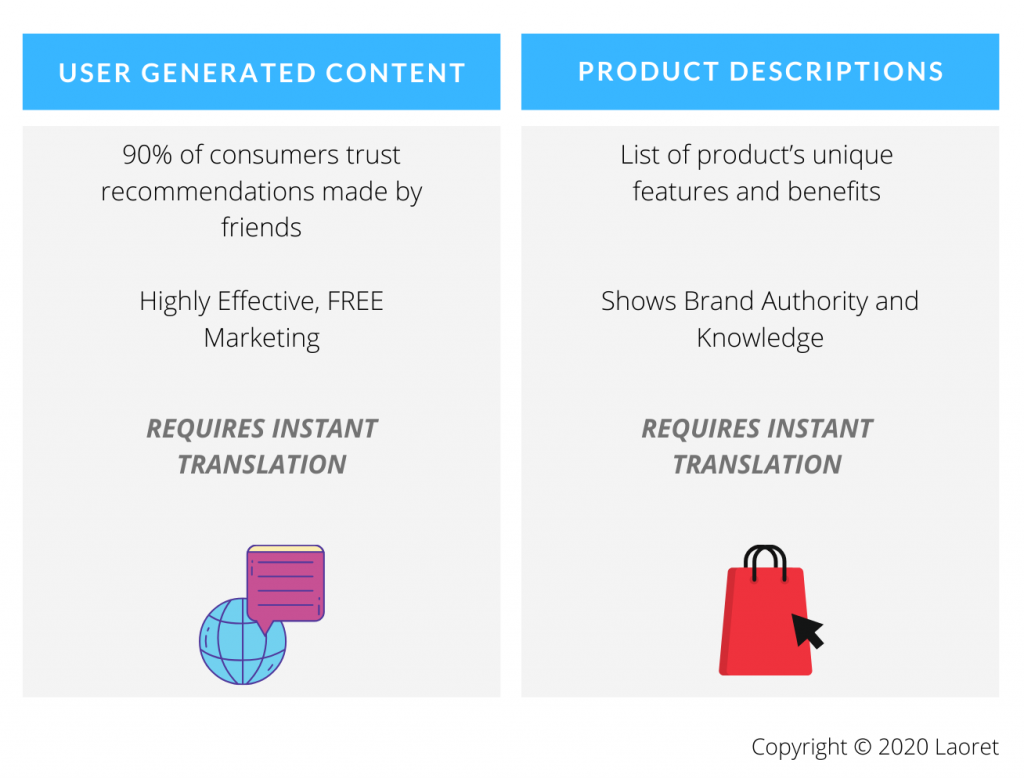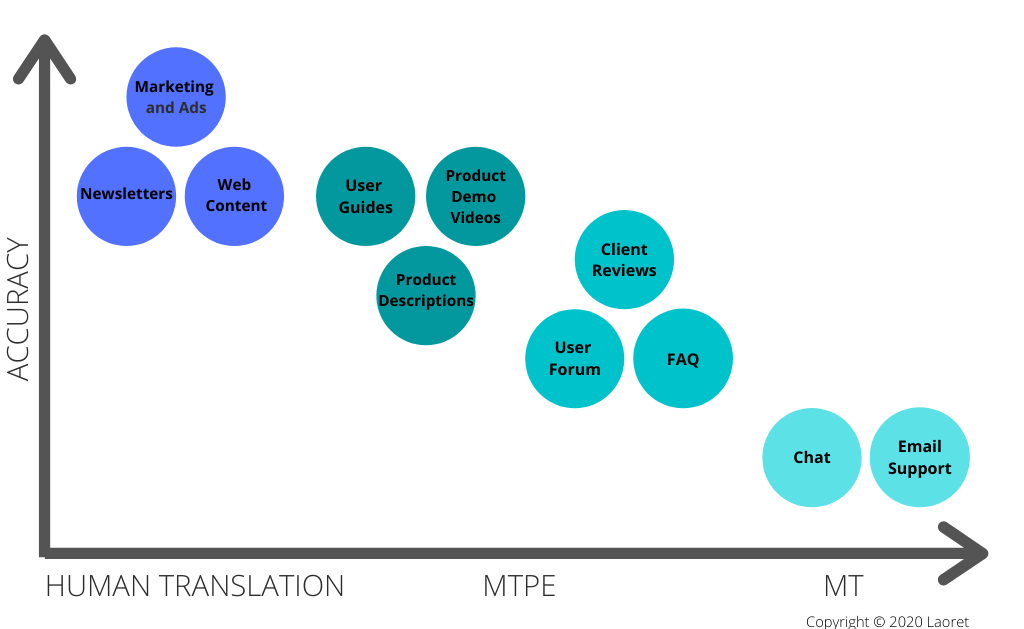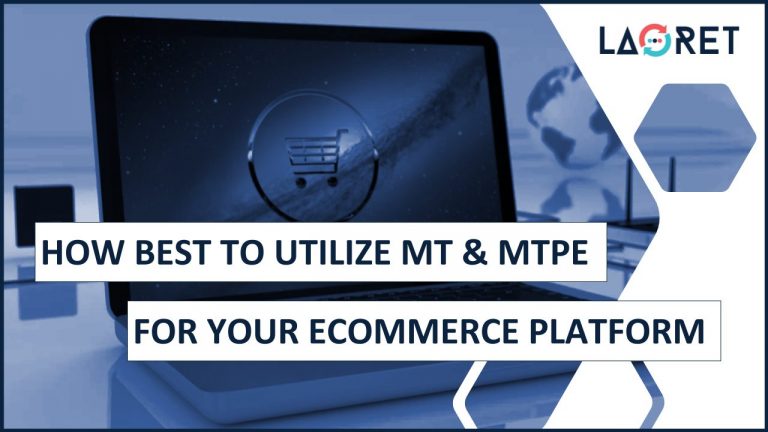How Best To Utilize MT & MTPE For Your eCommerce Platform
While English itself is still dominating the internet1, other languages like Chinese, Spanish, and Arabic, are growing more rapidly with internet use rising even within developing communities.
And since 55% of consumers2 prefer to buy exclusively in their native language and 53% are more comfortable when doing so, that is a pretty profitable market you could be tapping.
So, where does Machine Translation fit into the story?
In a 2018 research paper3, the question was posed whether Machine Translation (MT) affects international trade, using as a subject one of the largest eCommerce Platforms, eBay. The link between AI implementation and economic productivity, so the study confirms, became abundantly clear when eBay introduced Machine Translation for eCommerce business strategy, which registered a 17.5% increase in export to Latin American countries due to the fast and effective Spanish translations of their products descriptions and reviews.
Let us expand on how you can best leverage this major opportunity for global authority and what steps you need to take to maximize the potential of your eCommerce Platform.
Make Your Content Machine Translation-Ready
Machine Translation for eCommerce Platforms is best applied when you have an integration between your Content Management System (CMS), Translation (CAT)Tool, and MT-Engine, so you can connect your eCommerce Platform directly with your Language Service Provider. In terms of platforms, there are plenty of interesting options out there that can help boost translation efficiency and by extension, commercial productivity. You have the choice between Content-First options for eCommerce such as BigCommerce and Shopify.

When it comes to an effective and economical application of MT or Machine Translation Post-Editing (MTPE), it is essential to develop a content strategy long before running the text through the engine. With the implementation of a style guide, glossary, and Translation Memory (TM), you are setting up linguistic parameters to aid the translation (and Post-Editing) and as a result, obtain an output that is more closely aligned with your Brand Identity that improves over time.
Pro Tip! Learn More About Which Machine Translation Engine Works Best For Your Content Here Learn More About How MTPE Is Best Executed Here
- User-Generated Content (UGC) such as reviews and other feedback: Here is where the saying “People trust people, not brands†applies perfectly. TurnTo Networks published a report stipulating that 90% of consumers trust recommendations made by friends, while 20% of Millennials’ buying decisions are influenced by UGC. This makes UGC a form of free marketing that, due to the often steady flow of user feedback, can even be the most effective marketing strategy you possess. It provides authentic content that other users can trust, and can reach other channels through clients sharing the reviews or your product online. Making sure UGC gets translated quickly, should rank highly in your eCommerce Content Strategy.
- Product Descriptions: Well-crafted Product Descriptions that list a product’s unique features and benefits, and declares why this product is the indispensable problem solver clients are looking for, show crucial brand authority and subject-specific knowledge. The nature of Product Descriptions is that they appear on the platform regularly. If we have another look at the above mentioned eBay, the platform combines 1.3 billion listings with a 300 words average, and new ones popping up on a regular basis that will require almost instant translation.

Maximizing Dynamic Content Through Continuous Translation
How can you best utilize this content that can be such a game-changer for the international success of your business? By applying highly effective Translation Solutions. Since updates and consistent fresh content are the norms in the eCommerce business, Continuous Translation & Localization has developed into a benchmark within Translation Solutions where businesses are required to respond quickly to the needs of a changing market.
Effective translation automation is best achieved by maximizing the use of a Translation Management System (TMS) and a CAT-Tool through which:
- New content is seamlessly extracted and the translation is inserted within very short turnaround times (TAT)
- A Translation Memory (TM) can archive past translations to leverage
- Costs can be reduced and speedy sales can be accommodated
Continuous Translation is of particular interest when it comes to:
- eCommerce Platforms with a high number of customer inquiries looking into wider distribution and offer fast, multilingual support.
- Product reviews and evaluations to reach an international market.
- eCommerce sites that wish to expand their market through Mobile App Localization and need to enable in-app translation.
When To Use Machine Translation For eCommerce Platforms
It requires some business intelligence to decide whether to apply a plain Machine Translation or if it should be followed by Post-Editing. For this, we invite you to think about the balance between accuracy and speed, and where the content types lie within this margin. Going from the graph below, it is clear that chats, e-mail support, and Product Reviews demand a different level of translation quality and TAT as User Guides or Newsletters. There is a quality hierarchy that you will need to apply within your content strategy, dividing your content into the types that will boost sales through speedy action, or those that will increase buyer interest through a certain level of User Engagement and Marketing.

In this context, we would like to stress that Post-Editing as well as Localization Services, come with a handy set of locale-specific knowledge that you could leverage to promote cultural potency. Make use of these. Avoid making the mistake of running a translation through the MT-Engine hoping for speedy and economical translations, only to alienate a large portion of your audience.
Conclusion
Both Machine Translation and Machine Translation Post-Editing are essential translation strategies to promote a productive, economical, and internationally optimized eCommerce Platform. We strongly recommend that you determine which content could benefit from which method of translation, and enlist the services of an LSP, especially when post-edits, culture-savvy adaptations, and localization are required.
At Laoret, we offer Continuous Translation Solutions through our AI-Augmented Human Translations specifically designed for eCommerce Platforms. Laoret can also help you develop international Brand Equity through Localization Services, exclusively provided by native translators and highly specialized localization experts.
References
Looking for a quality vendor to
successfully translate your eCommerce Content?
We offer you a step by step overview of which tools, resources,
and experience your services provider should have and why!






